|
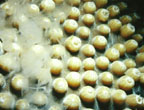
|
An annual, predictable event
of coral spawning occurs at the Flower Gardens
eight nights after the full moon in August. SSE
pilots and PI's will further investigate the
spawning click image for more... (photo:
Brenden Holland)
|
|
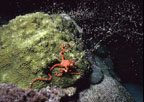
|
The broadcasting coral
spawners release their gametes synchronously around
the 8th and 10th night after the full moon in
August. Shown here, is a star coral,
(Montastraea franksi),click image for
more... (photo: Emma Hickerson)
|
|

|
Spiny or large flower coral -
(Mussa angulosa) - is one of the less common
species of coral found at the Flower Gardens, but
if click image for more... (photo: Frank and
Joyce Burek)
|
|

|
The ridges of the brain
coral, (Colpophylia natans), are truly a
work of art. If you look carefully you may see the
tiny round mouths of theclick image for more...
(photo: Frank and Joyce Burek)
|
|

|
Orange cup coral
(Tubastraea coccinea) is not found on any of
the Sanctuary Banks, but is found on oil platforms
in the area. (photo: Frank and Joyce Burek)
|
|

|
Parrotfish are often seen and
heard chewing on corals at the Flower Gardens.
Here, a star coral, (Montastraea sp.),
click image for more... (photo: Frank and
Joyce Burek)
|
|

|
As the reef gets deeper, and
less light is available, the shape of the corals
take on a flattened appearance. They are increasing
their surface area in order to maximize the amount
of light falling on their tissues which click
image for more... (photo: Frank and Joyce
Burek)
|
|

|
Elephant ear sponge,
(Agelas clathrodes), is a bright species of
sponge that is prominent on the reef. At certain
times of year click image for more...
(photo: Frank and Joyce Burek)
|
|

|
Touch-me-not-sponge
(Neofibularia nolitangere) and Y-branched
algae (Dictyota sp.)at Stetson Bank. The
temperatures at Stetson click image for more...
(photo: Frank and Joyce Burek)
|
|

|
Barrel sponge
(Xestospongia muta) and Tesselated blenny
(Hypsoblennius invemar) on the left, and a
seaweed blenny click image for more...
(photo: Frank and Joyce Burek)
|
|

|
Black-ball sponge (Ircinia
strobilina), great start coral (Montrastraea
cavernosa), and symmetrical brain coral,
(Diplora strigosa). click image for
more... (photo: Frank and Joyce Burek)
|
|

|
Smooth trunkfish juvenile
(Lactophyrys triqueter) reminds one of a
bumblebee. Photograph by Frank and Joyce
Burek
|
|

|
The smooth trunkfish
(Lactophrys triqueter) is usually black and
white in color, but at the Flower Gardens, Texas
A&M University fish click image for more...
(photo: Frank and Joyce Burek)
|
|
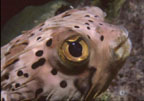
|
The balloonfish (Diodon
holocanthus) is usually a shy little fellow,
who retreats to a safe hole in the reef to peak out
warily. If they are startled, they inflate click
image for more... (photo: Ed Enns)
|
|

|
The spotted drum (Equetus
punctatus) is an elusive fish, but is found at
all three banks of the Sanctuary. Juveniles are
seen swimming in circular motions. (photo: Joyce
and Frank Burek)
|
|

|
This spotted scorpionfish
(Scorpaena plumieri) is well camouflaged
between the fire coral (Millepora
alcicornis), barnacles, red click image for
more...(photo: Frank and Joyce Burek)
|
|

|
This queen parrotfish
(Scarus vetula) is taking a bite out of some
coral, while a couple of juvenile bluehead wrasse
click image for more... (photo: Frank and
Joyce Burek)
|
|

|
Scrawled cowfish
(Lactophrys quadricornis) - a member of the
boxfish family. Found at all three banks the
Sanctuary. (photo: Frank and Joyce Burek)
|
|

|
The goldentail moray
(Gymnothorax miliaris) is one of only a few
species of eel found at the Flower Gardens and
Stetson Bank. click image for more...
(photo: Frank and Joyce Burek)
|
|

|
Jackknife fish (Equetus
lanceolatus) is uncommon, but diligent searches
can find them on all three banks, often under
ledges. click image for more... (photo:
Frank and Joyce Burek)
|
|

|
Whalesharks are seen every
year (but not on every cruise) during the latter
part of the summer, beginning at the end of July.
They are often click image for more...
(photo: Quenton Dokken)
|
|
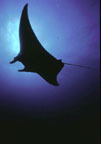
|
Manta rays, (Manta
birostris), may be encountered at the Flower
Gardens throughout the year. At least 35
individuals have been identified by Texas A&M
University marine ecologist, Jeff Childs. They have
identifying markings on their undersides. (photo:
Emma Hickerson)
|
|

|
Large juvenile Loggerhead sea
turtles, (Caretta caretta), are the most
common sea turtle encountered at the click image
for more... (photo: FGBNMS)
|
|

|
Atlantic thorny-oyster
(Spondylus americanus) are seen filter
feeding on all three banks of the Flower Gardens as
well as on the underwater structures of the
platforms. (photo: Frank and Joyce Burek)
|
|

|
The bearded fireworm
(Hermodice carunculata) is not something you
want to get personal with - their bristles can
easily penetrate and click image for more...
(photo: Frank and Joyce Burek)
|
|

|
Christmas tree worms
(Spirobranchus giganteus) are abundant
throughout the Sanctuary, and in many shades of
color. The two "trees" are the click image for
more... (photo: Frank and Joyce Burek)
|
|
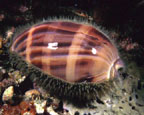
|
Shell collecting was once a
favorite pastime at Stetson Bank before it became
part of the Flower Garden Banks NMS in 1996. Shell
collecting is now a thing of the past, click
image for more... (photo: Frank and Joyce
Burek)
|
|

|
The long-spined urchin
(Diadema antillarum) experienced a
widespread die-off throughout the Caribbean in the
early 1980's. No reason click image for more...
(photo: Emma Hickerson)
|
|

|
This bar-eyed hermit crab
(Dardanus fucosus) was photographed at
Stetson Bank by Texas A&M click image for
more... (photo: Dr. Mary Wicksten)
|
|

|
Banded coral shrimp
(Stenopus hispidus) are sometimes seen
cleaning fish at cleaning stations -shrimp and some
species of fish clean click image for
more... (photo: Emma Hickerson)
|





